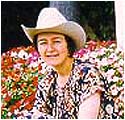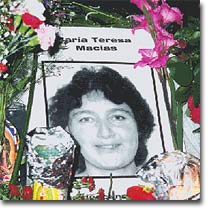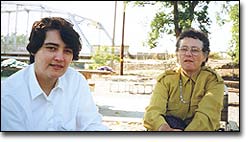
|
|
 |
The
Murder of
|
|
|
|
|
| The Legacy
of Teresa Macias ... Women's 14th Amendment Right to Equal Protection Established! July,
2000
On July 20, 2000, the U.S. 9th Circuit Court of Appeals reinstated Marķa Teresa Macias v. Sheriff Mark Ihde, the $15 million civil rights lawsuit filed in the wake of Teresa Macias' murder by her husband Avelino in 1996. With that ruling, the appellate court accomplished exactly what Teresa's mother and children intended when they filed suit: they changed the world. Three
days after Avelino Macias shot and killed Teresa, seriously wounded
her mother, Sara Rubio Hernandez, and then This victory was hard-fought, a testament to the determination of Teresa's family and local women's rights activists to roll back years of discrimination built into the constitution's 14th Amendment, which guarantees "equal protection under the law" -- to everyone except women. Just as school desegregation came only after years of struggle in the courts and in the streets, a woman's right to non-discriminatory protection by law enforcement has a history, not of compassionate patriarchs selflessly bestowing favors, but of women steadfastly refusing anything less than equal justice. And because this is your victory, we think you have a right to know how it happened. Investigating
the Investigators So in the days immediately after Teresa's murder, Tanya Brannan (Purple Berets) and Marie De Santis (Women's Justice Center), both bilingual women's rights advocates, set out to investigate Teresa's prior contacts with the Sonoma County Sheriff's Department and the district attorney's office. Just as we expected, we found and documented years of violence, stalking and sexual assault against Teresa and her children, all reported to the sheriff. In fact, in just the last three months of her life, after having obtained a restraining order, Teresa had called the Sheriff's Department more than 20 times to report Avelino's continued stalking, rape, false imprisonment, threats to kill and harassment, as well as his decade of violence against herself and her children. Yet despite a mandated arrest policy, Avelino was never arrested; only two police reports were written; no criminal charges were ever filed. Eyewitnesses
to Teresa's Fight to Survive
In excruciating interviews, Teresa's mother, and sister, Sara Rubio Hernandez and Ana Rosa Rubio, recounted how they had come to the U.S. to help Teresa free herself from Avelino's tyranny; how only days before the murder their hopes had been raised when Santa Rosa Police had put Avelino in handcuffs, only to release him at the request of a CPS worker; and how they had watched Teresa give up hope in those last days after, again and again, the sheriff protected Avelino instead of Teresa and her children. Sara, still hospitalized with gunshot wounds in both legs, gave an anguished account of Teresa's final, fruitless attempt to get police protection on that last day. When Avelino accosted them as they arrived for work Teresa said, "You know what to do, Mother," a signal for Sara to call 911. But it was already too late. Hearing the killing gunshot, Sara rushed to the door, only to see Avelino running toward her, shooting wildly. She barely got the door locked in time to save her own life. Friend and neighbor Marty Cabello, describing an earlier visit to the sheriff's substation to deliver evidence, said she was shouting, "He's going to kill her; he's told everybody he's going to kill her, and then his mother-in-law. You have to do something." Still the deputy made no arrest. The death threats weren't even mentioned in his report. Teresa's niece Monica Armstrong had often translated for her with sheriff's deputies. Monica angrily described the moment when police arrived to say her aunt was dead. "Are you guys happy now? Why are you telling me this now when you knew it was going to happen?" she asked. When police claimed they didn't know, she replied, "How could you not know?" Along with the eyewitness interviews, we were also collecting documentary evidence (police reports, court records, restraining order documents) using courthouse files and Public Records Act requests. Child Protective Services (CPS) records, though shrouded in secrecy and generally unavailable, were accessible to Teresa's next of kin. Those records were invaluable in documenting law enforcement's prior knowledge of the violence and danger to Teresa and her three young children, and of Teresa's fear for her life. (Footnote *) Later, as documentary evidence and personal testimony piled up and press coverage of our investigation sparked universal outrage, information began to flow more readily. Inside sources in the DA's and sheriff's offices, dismayed at the official cover-up, began to leak sensitive internal documents and information to us and to the press. The case began to take on a life of its own. Mourn
... and Organize Hundreds of people gathered to mourn Teresa and to honor her family's commitment that her death be used as a catalyst for change. Teresa's picture filled the square, as organizers detailed the sheriff's and district attorney's deadly role in this entirely preventable tragedy. The community unity generated by that event became the kernel of the public pressure campaign launched on the flood tide of media coverage then unleashed. That pressure took the form of letters to the editor, speak-outs in the Board of Supervisors chambers, meetings with public officials, radio talk shows, demonstrations and other public events. Teresa's photo was omnipresent wherever law enforcement issues were discussed, a constant reminder that police misconduct has two faces -- action and inaction -- both with equally deadly potential. As the pressure intensified and the revelations of law enforcement's failure became undeniable, outside agencies were drawn in. The state Attorney General investigated law enforcement's domestic violence practices and protocols. Even for then-Attorney General Dan Lungren (hardly a feminist!), the widespread disdain and incompetence investigators encountered was too shocking to be covered up. The report of the Attorney General's investigation gave high-level corroboration of the very charges against law enforcement that women activists had been making for years. Later, even the sheriff's own hand-picked Blue Ribbon Committee lambasted his and other county agencies' handling of the case and called for substantive changes in policies and protocols county-wide. The
Power of the Press After their initial reports of the homicide, the Santa Rosa Press Democrat steadfastly maintained the official silence on the murder. To break through this "white-out" we broke the story into the San Francisco media first, releasing the investigation the night of the vigil before the cameras of TV Channel 7. Once the San Francisco media picked up the story, the local press was shamed into covering it. Over the next weeks not a day passed without a huge front-page spread. Interestingly, with all the gallons of ink devoted to the case over the next months, the press never turned up one new fact; never generated one new piece of evidence; never found one additional witness. And despite basing all their coverage on our investigation, they only mentioned the Purple Berets once, reporting only that we had organized a memorial vigil. After the story broke we were constantly working with media to keep the story alive. For the Sonoma County Independent, we brought together other women whose domestic violence or sexual assault cases had been botched, proving that Teresa's treatment by law enforcement was everyday fare in our local criminal justice system. Channel 7's "I-Team" investigators did great follow-up stories on the domestic violence restraining order we had uncovered against sheriff's deputy Mark Lopez. (It was Lopez who had most often responded to Teresa's calls to law enforcement. He has since been fired.) Just as we were running out of ideas on how to keep the press interested, county officials handed us an opportunity. Six weeks after Teresa's death, the sheriff and district attorney called a "damage control" press conference. Women activists showed up early and en masse, armed with press statements, banners and posters of Teresa. By contrast, Sheriff Ihde and D.A. Mike Mullins arrived forty minutes late and looking haggard and afraid. They were unprepared with any new revelations, with their only solution a tired bumper sticker. Law enforcement looked worse than ever and the story was off and running again. Civil
Rights Lawsuit The family was lucky enough to connect with San Francisco-based civil rights attorney Dennis Cunningham and Rick Seltzer, whose Oakland law firm wanted to put back into the community some of the fruits of their success. Filed in October, 1996, Marķa Teresa Macias v. Sheriff Mark Ihde charges the sheriff discriminated against Teresa because she was a woman and a domestic violence victim; that such discrimination denied her equal protection of the law; and that, by failing to take reports, ignoring evidence, discouraging her from calling, etc., the sheriff emboldened Avelino, increasing the danger to Teresa and her children. With $15 million at stake, finally the floodgates to change flew open. Our biggest police agencies formed special domestic violence units, prosecution increased, victim support services doubled and tripled, and a new domestic violence court was established. Hammered by women's increasing demands for equal justice, law enforcement could no longer simply refuse to respond. Keep
Up the Fight for Women's Rights (Footnote *) CPS's role in the murder is another ugly chapter in this tragic story. In 1995, after receiving Teresa's report of Avelino's abuse of the children, CPS should have demanded that sheriff's deputies do their job to protect the children by arresting the abuser. Instead, they punished Teresa when they took her children, citing her inability to protect them from Avelino's violence. CPS then kept Teresa's head spinning, insisting that if she ever wanted her children back she had to attend counseling sessions with Avelino in an effort to reunify the family! It was CPS worker Suni Levi who, only days before the murder, had Santa Rosa police release Avelino, as if the couple's upcoming counseling session was more important than protecting Teresa's life. CPS also billed Teresa and Avelino for the cost of the children's foster care! According to one family friend, it was after receiving a bill from CPS for thousands of dollars that Avelino really began to unravel. But even after literally holding Teresa in place until Avelino could hunt her down and kill her, CPS still had one more ugly card to play. We were naive enough to think that after the murder the children, suffering the shocking loss of both their parents, would be immediately released from foster care and into the waiting arms of their grandmother and extended family. Instead, CPS held the children for five more months, and would have held them longer still had advocates and attorneys not intervened. (Back) The complete text of the ruling is available online at www.ce9.uscourts.gov. |
|
©
Tanya Brannan, Purple Berets
|
|
You
can copy and distribute this information at will
if you include credit and don't edit. |
|
|
|
Copyright
© 2001 Purple Berets
|
|
|
|
Web
Site by S.
Henry Wild
|
 turned
the gun on himself, the local newspaper ran a four-inch article,
buried on the inside pages and headlined "Cops Wrap Up Investigation."
That was intended to be the last you ever heard of Teresa Macias.
Instead, her murder has become a touchstone case in the fight
to end violence against women. And with this appellate court decision,
whether the lawsuit ultimately wins or loses in federal district
court, this ruling will be cited in cases across the nation establishing
at long last that women have a constitutional right to hold police
legally accountable for their response to violence against women.
turned
the gun on himself, the local newspaper ran a four-inch article,
buried on the inside pages and headlined "Cops Wrap Up Investigation."
That was intended to be the last you ever heard of Teresa Macias.
Instead, her murder has become a touchstone case in the fight
to end violence against women. And with this appellate court decision,
whether the lawsuit ultimately wins or loses in federal district
court, this ruling will be cited in cases across the nation establishing
at long last that women have a constitutional right to hold police
legally accountable for their response to violence against women.